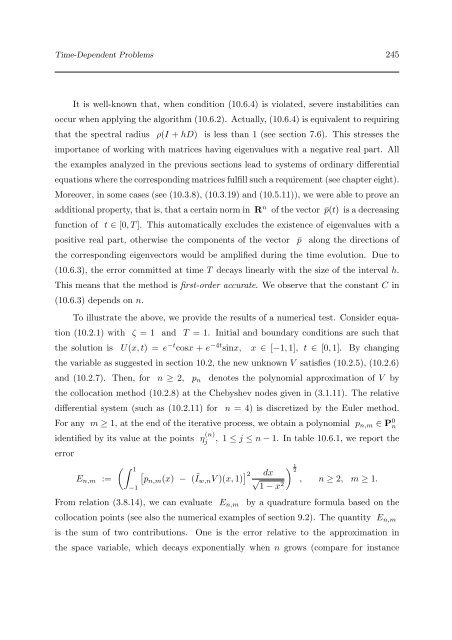Untitled - Cdm.unimo.it
Untitled - Cdm.unimo.it
Untitled - Cdm.unimo.it
Create successful ePaper yourself
Turn your PDF publications into a flip-book with our unique Google optimized e-Paper software.
Time-Dependent Problems 245<br />
It is well-known that, when cond<strong>it</strong>ion (10.6.4) is violated, severe instabil<strong>it</strong>ies can<br />
occur when applying the algor<strong>it</strong>hm (10.6.2). Actually, (10.6.4) is equivalent to requiring<br />
that the spectral radius ρ(I + hD) is less than 1 (see section 7.6). This stresses the<br />
importance of working w<strong>it</strong>h matrices having eigenvalues w<strong>it</strong>h a negative real part. All<br />
the examples analyzed in the previous sections lead to systems of ordinary differential<br />
equations where the corresponding matrices fulfill such a requirement (see chapter eight).<br />
Moreover, in some cases (see (10.3.8), (10.3.19) and (10.5.11)), we were able to prove an<br />
add<strong>it</strong>ional property, that is, that a certain norm in R n of the vector ¯p(t) is a decreasing<br />
function of t ∈ [0,T]. This automatically excludes the existence of eigenvalues w<strong>it</strong>h a<br />
pos<strong>it</strong>ive real part, otherwise the components of the vector ¯p along the directions of<br />
the corresponding eigenvectors would be amplified during the time evolution. Due to<br />
(10.6.3), the error comm<strong>it</strong>ted at time T decays linearly w<strong>it</strong>h the size of the interval h.<br />
This means that the method is first-order accurate. We observe that the constant C in<br />
(10.6.3) depends on n.<br />
To illustrate the above, we provide the results of a numerical test. Consider equa-<br />
tion (10.2.1) w<strong>it</strong>h ζ = 1 and T = 1. In<strong>it</strong>ial and boundary cond<strong>it</strong>ions are such that<br />
the solution is U(x,t) = e −t cosx + e −4t sinx, x ∈ [−1,1], t ∈ [0,1]. By changing<br />
the variable as suggested in section 10.2, the new unknown V satisfies (10.2.5), (10.2.6)<br />
and (10.2.7). Then, for n ≥ 2, pn denotes the polynomial approximation of V by<br />
the collocation method (10.2.8) at the Chebyshev nodes given in (3.1.11). The relative<br />
differential system (such as (10.2.11) for n = 4) is discretized by the Euler method.<br />
For any m ≥ 1, at the end of the <strong>it</strong>erative process, we obtain a polynomial pn,m ∈ P 0 n<br />
identified by <strong>it</strong>s value at the points η (n)<br />
j , 1 ≤ j ≤ n − 1. In table 10.6.1, we report the<br />
error<br />
En,m :=<br />
1<br />
−1<br />
<br />
pn,m(x) − ( Ĩw,nV )(x,1) <br />
2 dx<br />
√<br />
1 − x2 1<br />
2<br />
, n ≥ 2, m ≥ 1.<br />
From relation (3.8.14), we can evaluate En,m by a quadrature formula based on the<br />
collocation points (see also the numerical examples of section 9.2). The quant<strong>it</strong>y En,m<br />
is the sum of two contributions. One is the error relative to the approximation in<br />
the space variable, which decays exponentially when n grows (compare for instance
















